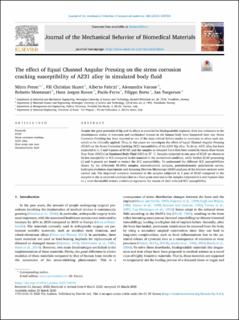| dc.contributor.author | Peron, Mirco | |
| dc.contributor.author | Skaret, Pål Christian | |
| dc.contributor.author | Fabrizi, Alberto | |
| dc.contributor.author | Varone, Alessandra | |
| dc.contributor.author | Montanari, Roberto | |
| dc.contributor.author | Roven, Hans Jørgen | |
| dc.contributor.author | Ferro, Paolo | |
| dc.contributor.author | Berto, Filippo | |
| dc.contributor.author | Torgersen, Jan | |
| dc.date.accessioned | 2021-04-22T11:11:58Z | |
| dc.date.available | 2021-04-22T11:11:58Z | |
| dc.date.created | 2020-11-26T22:30:44Z | |
| dc.date.issued | 2020 | |
| dc.identifier.citation | Journal of The Mechanical Behavior of Biomedical Materials. 2020, 106. . | en_US |
| dc.identifier.issn | 1751-6161 | |
| dc.identifier.uri | https://hdl.handle.net/11250/2739113 | |
| dc.description.abstract | Despite the great potential of Mg and its alloys as material for biodegradable implants, their low resistance to the simultaneous action of corrosion and mechanical stresses in the human body have hampered their use. Stress Corrosion Cracking has been reported as one of the most critical failure modes to overcome to allow such materials to be clinically applied. Thus, in this paper we investigate the effect of Equal Channel Angular Pressing (ECAP) on the Stress Corrosion Cracking (SCC) susceptibility of the AZ31 Mg alloy. To do so, AZ31 alloy has been subjected to 1, 2 and 4 passes of ECAP, and the samples so obtained have then been tested by means Slow Strain Rate Tests (SSRTs) in Simulated Body Fluid (SBF) at 37 °C. Samples subjected to one pass of ECAP are shown to be less susceptible to SCC compared to the material in the as-received condition, while further ECAP processing (2 and 4 passes) are found to worsen the SCC susceptibility. To understand the different SCC susceptibilities shown by the differently ECAPed samples, microstructural analyses, potentiodynamic polarization curves, hydrogen evolution experiments and Scanning Electron Microscopy (SEM) analyses of the fracture surfaces were carried out. The improved corrosion resistance of the samples subjected to 1 pass of ECAP compared to the samples in the as received condition (due to a finer grain size) and to the samples subjected to 2 and 4 passes (due to a more favourable texture evolution) represents the reason of their reduced SCC susceptibility. | en_US |
| dc.language.iso | eng | en_US |
| dc.publisher | Elsevier Science | en_US |
| dc.rights | Navngivelse 4.0 Internasjonal | * |
| dc.rights.uri | http://creativecommons.org/licenses/by/4.0/deed.no | * |
| dc.title | The effect of Equal Channel Angular Pressing on the stress corrosion cracking susceptibility of AZ31 alloy in simulated body fluid | en_US |
| dc.type | Peer reviewed | en_US |
| dc.type | Journal article | en_US |
| dc.description.version | publishedVersion | en_US |
| dc.source.pagenumber | 14 | en_US |
| dc.source.volume | 106 | en_US |
| dc.source.journal | Journal of The Mechanical Behavior of Biomedical Materials | en_US |
| dc.identifier.doi | 10.1016/j.jmbbm.2020.103724 | |
| dc.identifier.cristin | 1853175 | |
| dc.relation.project | Norges forskningsråd: 295864 | en_US |
| dc.description.localcode | This is an open access article distributed under the terms of the Creative Commons CC-BY license, which permits unrestricted use, distribution, and reproduction in any medium, provided the original work is properly cited. | en_US |
| dc.source.articlenumber | 103724 | en_US |
| cristin.ispublished | true | |
| cristin.fulltext | original | |
| cristin.qualitycode | 1 | |

